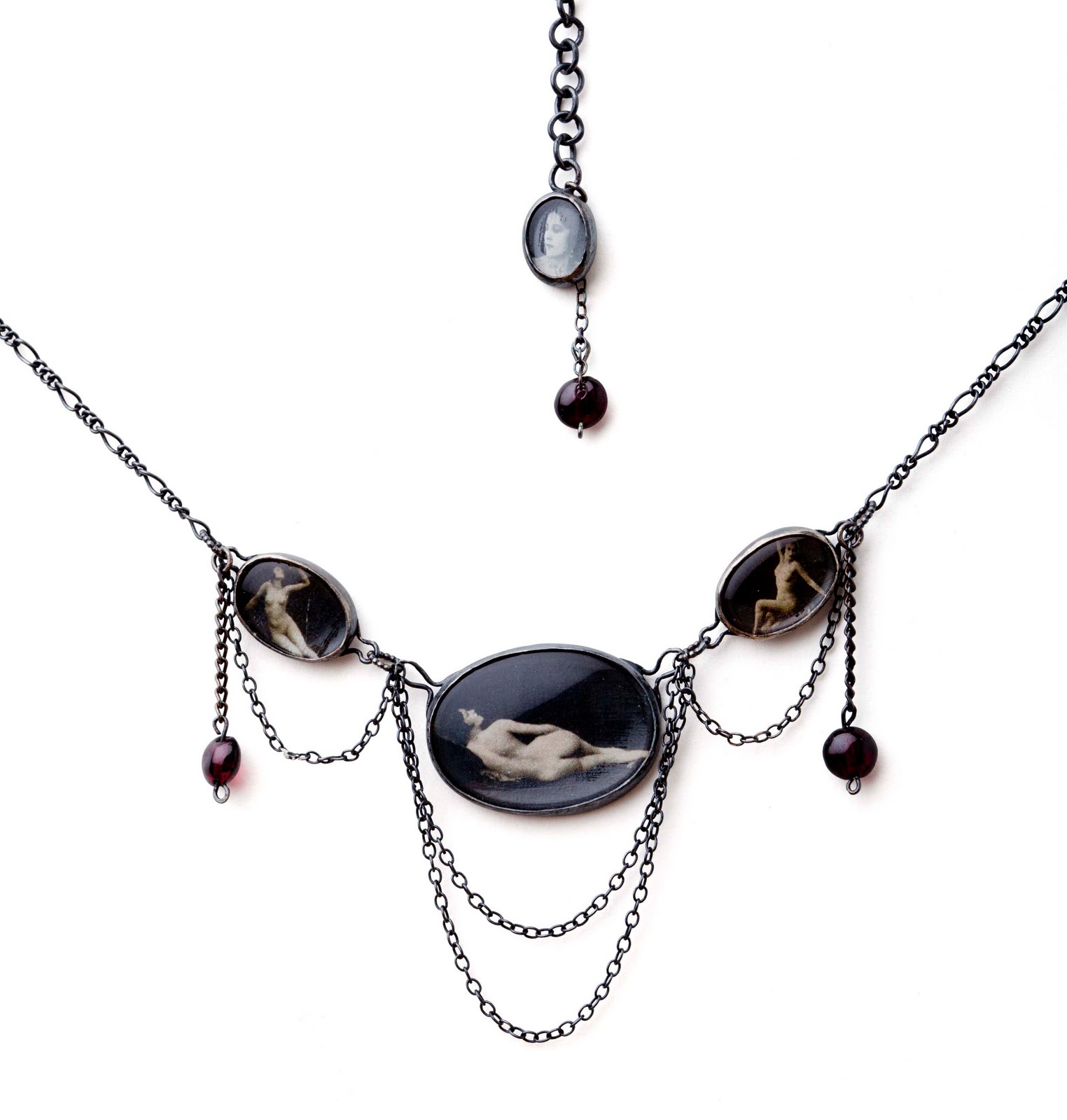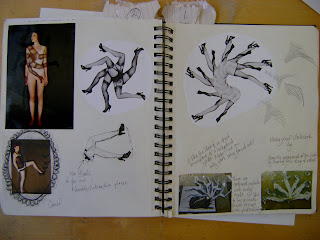






 Catherine Chester introduces us to her latest range of jewellery and her incorporation of fabric into wearable art. Talking us through her inspiration, stimulus and practice; she outlines what exactly it is that gets her all laced up. Tell me about the motivations behind your work. What provokes your thoughts and inspires your designs?
Catherine Chester introduces us to her latest range of jewellery and her incorporation of fabric into wearable art. Talking us through her inspiration, stimulus and practice; she outlines what exactly it is that gets her all laced up. Tell me about the motivations behind your work. What provokes your thoughts and inspires your designs?"I draw my inspiration mainly from interacting with first-hand sources. In particular, I love to engage with the materials I plan to use before I go about creating a piece. The way I work best is to simply lie out all of my materials, scraps of metal and fabric then play with them. I will lay out separate piles of materials that work well together, both on a textural basis and also in an aesthetic way. I consider weight, flexibility, colour, how the materials will move with the wearer, and how the combination of materials will work together on the body. I may start by perhaps simply running lace through my fingers, photographing the ways in which it rests on the contours of the body and then I will use this exercise as a starting point for designing a piece. I think that being able to engage with peoples' senses is an integral part of my work and through interacting with the raw materials I am given a flavour of how the wearer may respond my pieces."
So would you say that textiles are your main material focus?
"Not my main material focus, I love using metals in my work too. I would say that fabric is my main starting point and from studying its composition I inspired to interpret into ways of interpreting it in new forms. For example, I've been experimenting with lots of new techniques in metal work recently such as etching and imprinting which has allowed me to transform the lace into a metal representation of the fabric. The metal allows fabric to be transformed into something durable. But as well as interpreting the fabric I also like to incorporate it directly into the work. I love the contrast between metal and fabric and I think there's an interesting juxtaposition of texture and weight when the two are put together.
You said that you've been experimenting with new metal techniques recently. How do these technical processes inform your work? How do you learn from experimenting in the workshop?
"Well my work is dominated by my range of knowledge of processes. Although I am becoming proficient in many techniques, there is still a mass of untouched ground that I plan to conquer. I try to study one process at a time and practice it until I master it but often I find myself trying to run before I can walk. When I design a piece and have an idea of what I want it to look like and it frustrates me having to research the technical side of it before I can role my sleeves up and get stuck in. But as well as studying the technicalities of jewellery-smithing I have also learnt a lot from simply getting my hands dirty and asking almost juvenile questions such as 'what would happen if I set fire to this?' or 'what happens if you stick this in a bucket of acid?' I've had many successful outcomes from using my instincts and even when I end up just setting fire to the workshop it is still a useful experience to learn from. I think that one of my strengths as a designer is that I try to gain as much as I can from each experiment. I have piles and piles of notebooks that I record my experiments in along with photographs that I go back to every time I design a piece related to that area.
Have you ever found anything interesting from unexpected outcomes?
"Absolutely! It's the most fun and creative method. There was one experiment in particular where I had crocheted some little flowers and I was trying to cast them in to pewter. I decided to see what would happen if I simply poured the molten pewter over the top but I hadn't anticipated that the doily would float to the surface of the pewter! The doily got partially coated in the pewter and stuck in it as it cooled down. What was so interesting about this experiment, that I have used to my advantage since then is that the doily didn't burn because pewter has such a low melting point. Subsequently I've made some very interesting samples with this knowledge by incorporating fabric and pewter together.
Can you describe one of your favorite pieces- how did it come about? How was it designed? How was it produced?
One of my favorite pieces is my 'Etched Coiled Copper Cuff'. I designed it by using my usual method of having a rummage around my material bag and playing with a piece of lace that caught my eye. I began by wrapping it around my wrists and trailing it over my hands. What I tried to capture in this piece was the movement and layering of the lace when it was wound around the body. I wanted to represent this movement in metal so I began experimenting by rolling strips of copper until they were thin enough to coil-up and act like a spring that could be wrapped round the wrist. I then began experimenting with methods of transferring the pattern of the lace onto the metal. I did numerous trials of etching and recording the length of time it took to etch away a deep enough impression of the lace whilst still attempting to capture its delicacy. Once I'd managed to get a good enough impression printed onto the thin copper, I decided that there were particular qualities in the lace that I wanted to make stand out because they were what attracted me to the pattern in the first place. I liked the ruffled edging on the lace and decided that to pick this detail out more I could cut around its edge by using a piercing saw. Then, by using a hammer I carefully tapped the metal into the form of the coil and polished it up. I think the piece is so effective because it is a perfect representation of my initial stimulus; me playing with a piece of lace. But I feel that not only have I represented a playful notion, I have also transformed a piece of fabric into a durable piece of wearable art through material and process exploration.
Do you consider there to be a significant differentiation between the terms 'jewellery' and 'Wearable Art'?
I would certainly describe my own work as wearable art. I think that I would consider anything that is defined as 'jewellery' to be designed using a different thought process to 'wearable art'. 'Jewellery' is designed preliminary with the consumer market in mind as opposed to the portrayal of a particular notion or theme, which essentially is how I work. Of course every artist has to consider their market when creating pieces to sell, but their designs are dominated by their particular ideology and marketing comes as a secondary consideration. 'Jewellery' is also something that is often mass-produced or re-created. I think that an item shifts into a new category when it is a one-off piece that has taken hours to be handcrafted and is therefore unique. All of my designs are one-off pieces of art and it is my obsession with the human form that wants them to be wearable.
What is it about the human form that informs your designs?
When I look at the body principally I see contours that need to be filled. If I'm holding an object in my hands, I'll look in the mirror and instinctively see a gap that needs filling. I'll hold it to the crook of my neck or trail it around my wrists until I find a hole that it sits in. Body adornment should compliment the curves of the body without detracting attention from them. It should also reflect on the wearer's personality. When designing pieces I will consider how a material will move with the wearer and I will study the human form in order to capture this movement. I sketch the body constantly in order to gain a sense of human fluidity and how it can be adorned and complimented.
What influences do you draw upon other than the body and the materials you adorn it with?
I look to other practitioners in similar fields as me. In particular, I find the work of the textile jeweller Arline Fisch incredibly inspirational. I feel that her techniques and processes bare similarities to my own interests. I like to incorporate fabric into my jewellery work where possible and I feel that Arline highlights the qualities that I try to achieve in jewellery which are the representation of the delicacy and flexibility of fabric. Arline works with traditional textile techniques such as crochet and knitting but she often uses wire to create her jewellery from. I have incorporated many of her techniques into my designs and I feel that the link between metal and textiles is where my passion lies and through looking at Arline's work I can explore this border further.
Where do you see yourself in 10 years time?
Well ideally I’d love to be doing what Arline Fisch is doing. The way she manages her career is very balanced between creating the unique works of art and making a stable income as a teacher. She values herself as an artist and only creates pieces that are of specific interest to her. The fact that she doesn’t batch-produce items specifically to sell and make profit, means that it is difficult to find a wide market. For this reason, she has a variety of methods of supporting herself so that she can continue her career as an art-jeweller, such as tutoring, lecturing and writing textbooks. I’d be happy if I could have my own metal workshop to create pieces as and when I like but I’d also like the stability and variation of having a side-career that could introduce new students into the art-world.
…And the ten years before you get there?
I think I’ll set fire to the workshop some more! Definitely lots more specializing in the thousands of techniques that are ahead of me until I’ve conquered them all and completed transition from ‘student designer’ to ‘metal smith’; then I’ll think about getting my own workshop to set fire to!



































